
Data-driven content strategies are a hot marketing industry trend at the moment, but this is a trend that has some legs. After all, why not make all the data you gather from current and potential customers work for you?
You see, data is the real MVP of marketing: It can be used to measure the effectiveness of your campaigns, track the overall health of your brand, and (when used properly) it can help to spark new content ideas.
And if you need some inspiration, I put together a roundup of some brands that are using data to fuel really compelling and sharable stories. Check them out below.
7 Examples Of Data-Driven Storytelling By Leading Brands
1) OkCupid
OkCupid has all the demographic and connection information that one would expect from an extremely popular online dating site. But instead of keeping this info totally internal, it uses the trends and statistics to create interesting, data-driven posts that are also extremely popular on social media due to the compelling topics.
And let’s not forget the funny, clever, and insightful quizzes that users can and do answer, and how OkCupid uses that data to craft equally funny, clever, and insightful posts.
Recommended Content:
One popular post -- “Don’t Be Ugly By Accident” -- talks about crafting great profile pictures for online dating, but the advice is applicable to virtually anyone who wants to put their best foot forward online, whether it is a dating site, Facebook, or LinkedIn.
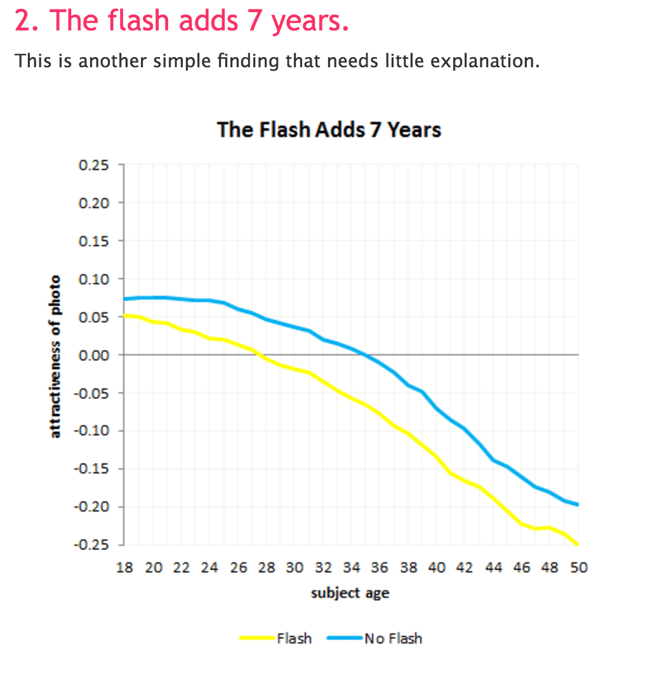
2) GrubHub
The folks at GrubHub know what you eat, where you eat it, and when you order it. While this might seem a little mundane, the food delivery app mines this data and turns it into unique content like quizzes, contests, polls, and special offers.
GrubHub also partners with various publishers who use the data to create compelling native advertising that hardly feels like stereotypical sponsored content.
Recommended Content:
Leading up to the U.S. Presidential election, GrubHub created a quiz together with Time Magazine to see whether or not your dietary preferences were Democrat or Republican based on user data overlaid with voting/polling data for the same area.
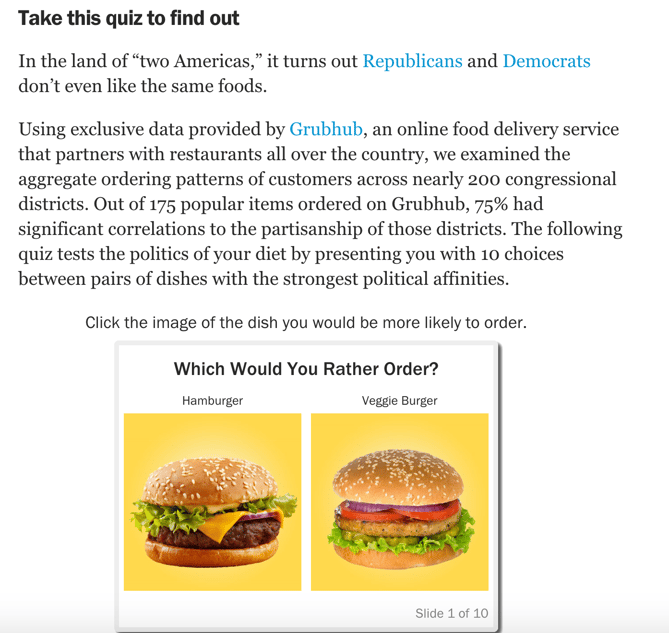
3) Jawbone
The team behind Jawbone wants people to be healthy and live better lives. Beyond enabling users to track their own personal data through the fitness band, Jawbone uses that data to support its content creation efforts.
The content produced typically involves making predictions and then providing corresponding advice based on the research it does into its user bases' behavior.
The key takeaway for other brands here? Look for ways to use your data and the learnings you take away from it to provide actionable tips and advice that make a real difference in your user’s lives.
Recommended Content:
"How University Students Sleep" discusses the sleep trends on some of America’s premier campuses and shows how sleep can affect learning and performance -- a topic that's directly tied to the data Jawbone collects. This information is relevant to almost everyone, but perhaps particularly relevant to younger demographic -- one that is likely interested in using the product.
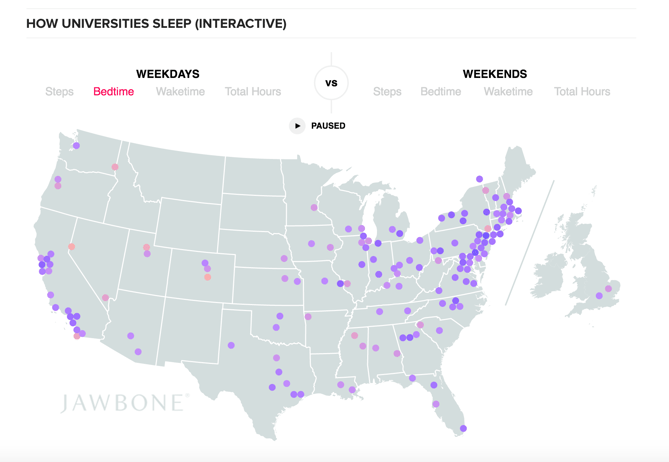
4) Zillow
Real estate has always been a data-centric profession -- from pricing data to demographic data, and much more. And Zillow takes it to the next level by leveraging the vast amounts of data in its real estate platform to create content that is useful and compelling for current buyers, sellers, and real estate agents, as well as others with a general interest in the industry.
Take a lesson from Zillow and use your data to tell stories that have a broader appeal than your exact target demographic who is ready to convert. Make your content interesting on its own, and position yourself as an authority in your space or community.
Recommended Content:
Everyone wants to add value to whatever it is they are promoting or selling, so Zillow used content from successful listings to determine what words they all had in common. The result? This article: "15 Words That Could Add Value To Your Listing." Straight to the point and actionable, this is news that Zillow’s audience can certainly use, and it has the data to back it up.
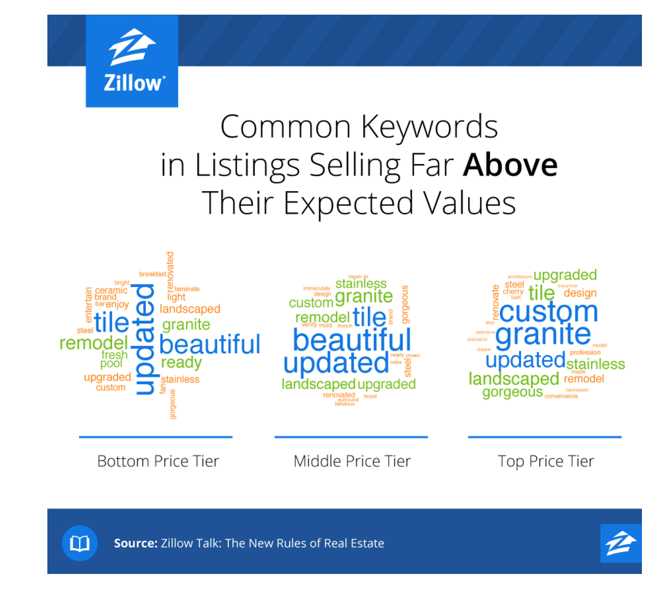
5) Spotify
The popular music app Spotify does more than provide you with some excellent tunes. Instead it takes things a step further by using to data to create custom playlists based on your listening activity, the time of day, current season, and so on.
They also compile “year of” playlists showing not only the most popular songs of the year, but also when they were popular -- sparking memories and happy reminiscing.
Recommended Content:
An oldie (for the internet at least) but a goodie, this 2013 post outlining how Spotify uses analytics and data to produce playlists and other content is still pretty darn relevant and useful.

6) Uber
Having an online newsroom or company announcement page is pretty standard, but the tremendously popular peer-to-peer ridesharing service Uber features much more than the expected updates or self-promotional posts.
Instead, it uses its vast amount of data to show users the value of its service and make connections where most brands wouldn’t -- sparking a conversation that is not only about its drivers and riders, but about society and human behavior in general.
Recommended Content:
"Ten facts you may not know about Uber drivers," is not only interesting in a slice-of-life type of way (who doesn’t want to know more about the people driving you around) but points to major societal trends as well. Even if you don't use Uber, the article provides a compelling story about the types of people working as drivers.
For instance, did you know that 24% of Uber drivers are entrepreneurs using the flexibility and steady income from the app to support their own business development?
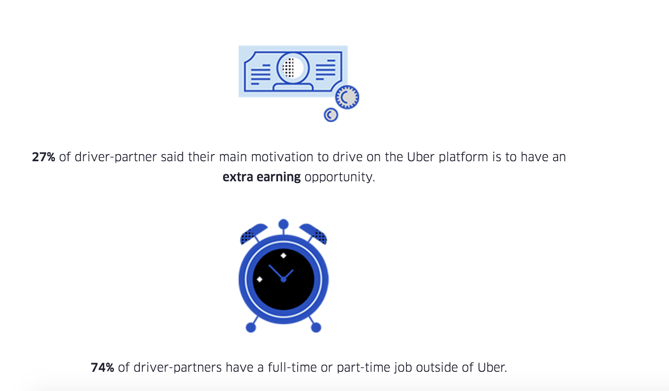
7) Mint
As the personal finance gurus of the millennial generation, Mint often uses its vast amounts of data about its audience’s finances and spending habits to create infographics centered around timely topics.
The lesson? Take a look at Google Trends or use anything you’ve noticed in the news or our collective internet pop culture, see what statistics or behaviors from your users might apply or be connected to it somehow, and make it a story. Bonus points for creative and shareable visuals, and finding ways that your data satisfies the innate curiosity about what our fellow human beings are up to.
Recommended Content:
Mint’s Millennials and Charity Infographic -- timed for and posted during the holiday season -- might be the perfect mix of data, trends, and a compelling, relevant, and newsworthy topic.

Ready to tell your data's story?
Of course, you might not have the budget or access to the sheer volume of user data that some of these relatively big brands do, but nearly all marketers, content creators, and business owners have access to data that can be used to tell a story.
For instance, restaurant owners know what the most popular dishes are, boutique owners know the latest trends amongst their crowd (e.g., microtrends in a given neighborhood or amongst a given style subset), and B2B brand marketers probably have an idea of where the industry is going based on the questions their customers are asking and the keywords that drive users to their websites and landing pages.
Every type or marketer works with data all the time, whether that means using analytics to track user behavior and conversions to analyzing statistical information about the target audience and their interests and demographic make-up. It’s a fundamental aspect of the business, and we all use it to inform our process and measure our efforts -- but companies like the aforementioned brands can and do take it to the next level.
What are your favorite examples of data-driven storytelling? Share them in the comments.
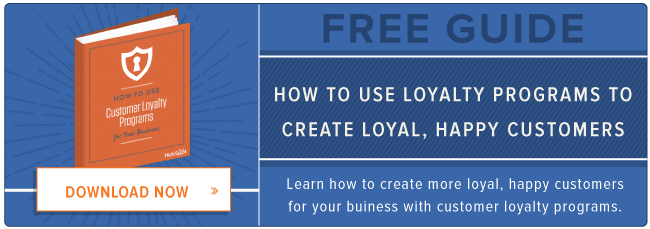
from HubSpot Marketing Blog http://blog.hubspot.com/marketing/data-driven-storytelling-brand-examples
No comments:
Post a Comment